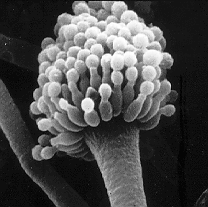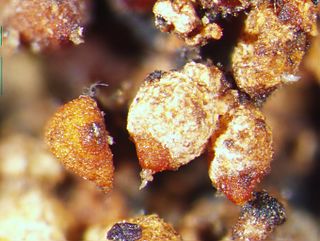Related Research Articles
In particle physics, a hadron is a composite particle made of two or more quarks held together by the strong force in a similar way as molecules are held together by the electromagnetic force. Most of the mass of ordinary matter comes from two hadrons, the proton and the neutron.

The Solar System is the gravitationally bound planetary system of the Sun and the objects that orbit it, either directly or indirectly. Of the objects that orbit the Sun directly, the largest are the eight planets, with the remainder being smaller objects, such as the five dwarf planets and small Solar System bodies. Of the objects that orbit the Sun indirectly—the moons—two are larger than the smallest planet, Mercury.

Symbiosis is any type of a close and long-term biological interaction between two different biological organisms, be it mutualistic, commensalistic, or parasitic. The organisms, each termed a symbiont, may be of the same or of different species. In 1879, Heinrich Anton de Bary defined it as "the living together of unlike organisms". The term was subject to a century-long debate about whether it should specifically denote mutualism, as in lichens; biologists have now abandoned that restriction.

A sepal is a part of the flower of angiosperms. Usually green, sepals typically function as protection for the flower in bud, and often as support for the petals when in bloom. The term sepalum was coined by Noël Martin Joseph de Necker in 1790, and derived from the Greek σκεπη (skepi), a covering.

Collaboration is the process of two or more people or organizations working together to complete a task or achieve a goal. Collaboration is similar to cooperation. Most collaboration requires leadership, although the form of leadership can be social within a decentralized and egalitarian group. Teams that work collaboratively often access greater resources, recognition and rewards when facing competition for finite resources.
Alex Kurtzman is an American film and television writer, producer, and director. He is best known for executive producing the Star Trek franchise since 2017, co-writing the scripts to Transformers, Star Trek, Star Trek Into Darkness, and The Amazing Spider-Man 2 with his writing and producing partner Roberto Orci, and directing and co-writing The Mummy.
Penicillium claviforme is a species of Penicillium within the phylum Ascomycota.
This is a glossary of some of the terms used in phytopathology.
Hyphomycetes are a form classification of Fungi, part of what has often been referred to as Fungi imperfecti, Deuteromycota, or anamorphic fungi. Hyphomycetes lack closed fruit bodies, and are often referred to as moulds. Most hyphomycetes are now assigned to the Ascomycota, on the basis of genetic connections made by life-cycle studies or by phylogenetic analysis of DNA sequences; many remain unassigned phylogenetically. Identification of hyphomycetes is primarily based on microscopic morphology including: conidial morphology, especially septation, shape, size, colour and cell wall texture, the arrangement of conidia as they are borne on the conidiogenous cells, the type conidiogenous cell, and other additional features such as the presence of sporodochia or synnemata.

A chemical compound is a chemical substance composed of many identical molecules composed of atoms from more than one element held together by chemical bonds. A chemical element bonded to an identical chemical element is not a chemical compound since only one element, not two different elements, is involved.
Graphium is a genus of fungi in the family Microascaceae. Many species are known as plant pathogens. Graphium belongs to the group hyphomycetes and has about 20 species. They are found in soil, plant debris, woody substrate, manure, and polluted water. The sporulating structures of Graphium form synnema, which are a gathering of conidiophores into a sort of flower bouquet. Graphium spp. are recognized by their distinctive, erect, black synnemata, each bearing a single, terminal, ball of one-celled, hyaline conidia produced from annellides.
Conidiomata are blister-like fruiting structures produced by a specific type of fungus called a coelomycete. They are formed as a means of dispersing asexual spores call conidia, which they accomplish by creating the blister-like formations which then rupture to release the contained spores.

The fungi imperfecti or imperfect fungi, also known as Deuteromycota, are fungi which do not fit into the commonly established taxonomic classifications of fungi that are based on biological species concepts or morphological characteristics of sexual structures because their sexual form of reproduction has never been observed. Only their asexual form of reproduction is known, meaning that these fungi produce their spores asexually, in the process called sporogenesis.
Actinosynnema is a genus in the phylum Actinobacteria (Bacteria).
Elophila difflualis is a species of moth of the family Crambidae. The species was first described by Pieter Cornelius Tobias Snellen in 1880. It is found in South-East Asia, in Australia and Réunion but has also be introduced to the United Kingdom.
Ophiostoma himal-ulmi is a species of fungus in the family Ophiostomataceae. It is one of the causative agents of Dutch elm disease. It was first isolated around breeding galleries of scolytid beetles in the bark of Ulmus wallichiana. This, together with the fact that it is endemic to the Himalayas, is the reason it is named himal-ulmi. It is outcrossing and heterothallic, with two sexual compatibility types: A and B, occurring in a near 1:1 ratio in nature. It also exhibits a distinctive colony type, an ability to produce synnemata on malt extract agar, production of perithecia with long necks, a very high level of cerato-ulmin toxin production in liquid shake cultures, and moderate to strong vascular wilt pathogenicity on Ulmus procera.

Corallonectria is a genus of ascomycete fungi in the family Nectriaceae. Species of Corallonectria are Neotropical. These fungi are characterized by the formation of brightly colored rhizomorphs and of copulated synnematous fusarium-like asexual morphs in culture. The asexual morph in nature has been rarely observed. The sexual fruiting bodies are furfuraceous and usually seated at the base of a reddish synnemata. It is a monotypic genus containing the sole species Corallonectria jatrophae. This species was formerly classified under Corallomycetella.
Ophiostoma breviusculum is a species of fungus in the family Ophiostomataceae, associated with bark beetles infesting larch in Japan. It belongs in the Ophiostoma piceae complex. It was also found in insect galleries of Larix kaempferi. The length of its perithecial necks and synnemata are shorter than in O. piceae. The synnemata also differ from the latter morphologically.
Petriella setifera is a fungus commonly found in soil and feces. The fungus has also been located on wood rot, plant species, and compost. A significant portion of P. setifera reports are found on sources with no previous association with the fungus. There are no known human cases of fungal infection, but one reported case of a dolphin infection. The fungus may have immunosuppressive characteristics, but it has not been confirmed. Many properties of the fungus are unknown, requiring further research.
References
- ↑ "Synnema". Dictionary.com. Retrieved 14 June 2012.
- ↑ Cortez, K. J.; Roilides, E.; Quiroz-Telles, F.; Meletiadis, J.; Antachopoulos, C.; Knudsen, T.; Buchanan, W.; Milanovich, J.; et al. (2008). "Infections Caused by Scedosporium spp". Clinical Microbiology Reviews. 21 (1): 157–97. doi:10.1128/CMR.00039-07. PMC 2223844 . PMID 18202441.
| This mycology-related article is a stub. You can help Wikipedia by expanding it. |